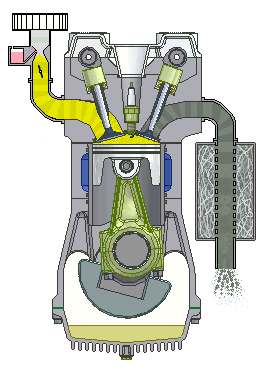Difference between revisions of "Engine compression"
m (Protected "Engine compression" ([Edit=Allow only administrators] (indefinite) [Move=Allow only administrators] (indefinite))) |
|
(No difference)
| |
Revision as of 02:13, 3 April 2020
Contents
Definition
In a combustion engine, the static compression ratio is calculated based on the relative volumes of the combustion chamber and the cylinder. It is a fundamental specification for combustion engines. The dynamic compression ratio is a more advanced calculation which also takes into account gasses entering and exiting the cylinder during the compression phase.
Most engines used a fixed compression ratio, however a variable compression ratio engine is able to adjust the compression ratio while the engine is in operation. The first production engine with a variable compression ratio was introduced in 2019.
Effect and typical ratios
A high compression ratio is desirable because it allows an engine to extract more mechanical energy from a given mass of air–fuel mixture due to its higher thermal efficiency. This occurs because internal combustion engines are heat engines, and higher compression ratios permit the same combustion temperature to be reached with less fuel, while giving a longer expansion cycle, creating more mechanical power output and lowering the exhaust temperature.
Gasoline engines
In production gasoline (petrol) engines from the past 20 years, compression ratios are typically between 8∶1 and 12∶1. Several production engines have used higher compression ratios, including:
- Cars built from 1955–1972 which were designed for high-octane leaded gasoline, which allowed compression ratios up to 13∶1.
- Some Mazda SkyActiv engines released since 2012 have compression ratios up to 14.0∶1. The SkyActiv engine achieves this compression ratio with ordinary unleaded gasoline through improved scavenging of exhaust gases (which ensures cylinder temperature is as low as possible before the intake stroke), in addition to direct injection.
- The 2014 Ferrari 458 Speciale also has a compression ratio of 14.0∶1.
When forced induction (e.g. a turbocharger or supercharger) is used, the compression ratio is often lower than naturally aspirated engines. This is due to the turbocharger/supercharger already having compressed the air before it enters the cylinders. Engines using port fuel-injection typically run lower boost pressures and/or compression ratios than direct injected engines because port fuel injection causes the air/fuel mixture to be heated together, leading to detonation. Conversely, directly injected engines can run higher boost because heated air will not detonate without a fuel being present.
Higher compression ratios can make gasoline engines subject to engine knocking (also known as "detonation", "pre-ignition" or "pinging") if lower octane-rated fuel is used. This can reduce efficiency or damage the engine if knock sensors are not present to modify the ignition timing.
Diesel engines
Diesel engines use higher compression ratios than Gasoline engines, because the lack of a spark plug means that the compression ratio must increase the temperature of the air in the cylinder sufficiently to ignite the diesel. Compression ratios are often between 14∶1 and 23∶1 for direct injection diesel engines, and between 18∶1 and 23∶1 for indirect injection diesel engines.
Since diesel engines operate on the principle of compression ignition, a fuel which resists autoignition will cause late ignition, which can lead to engine knock. Diesel engines have a higher peak combustion temperature than gasoline engines, but the greater expansion means they eject less heat in their cooler exhaust.
Other fuels
The compression ratio may be higher in engines running exclusively on LPG or compressed natural gas, due to the higher octane rating of these fuels.
Racing engines
Racing engines often run on high octane gasoline and can therefore use higher compression ratios. For example, motorcycle racing engines can use compression ratios as high as 14.7∶1, and it is common to find motorcycles with compression ratios above 12.0∶1 designed for 86 or 87 octane fuel. F1 engines come closer to 17∶1, which is critical for maximizing volumetric/fuel efficiency at around 18,000 RPM.
Ethanol and methanol can take significantly higher compression ratios than gasoline. Racing engines burning methanol and ethanol fuel often have a compression ratio of 14∶1 to 16∶1.
